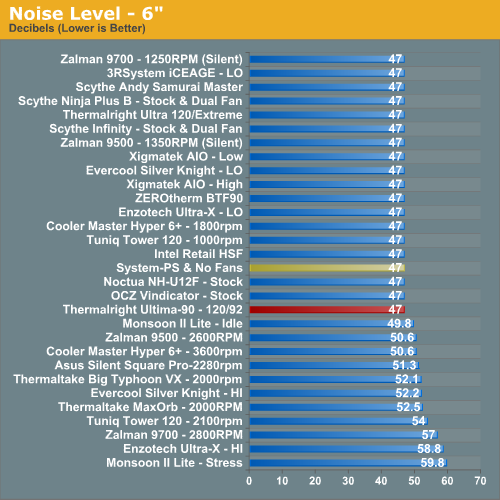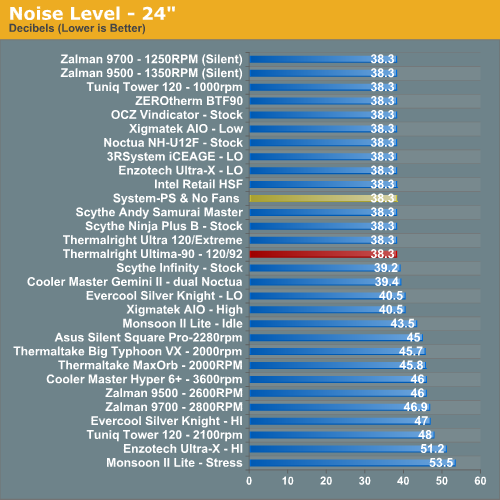Thermalright Ultima-90: Small Wonder?
by Wesley Fink on August 20, 2007 2:00 AM EST- Posted in
- Cases/Cooling/PSUs
Noise
For many enthusiasts upgrading cooling the goal is maximum stable overclock, and they will live with the inconvenience of a louder system. For other users silence is the most important factor, and these users will forgo maximum overclocking if that increases system noise levels.
There are very few power supplies that do not have a fan. While Zalman and a few others do make expensive fanless power supplies, we have not seen a fanless unit larger than 500W, or one that would be used for seriously overclocking a system. With that in mind the noise level of the system with all fans turned off except the PSU was measured. The power supply used for the cooling test bed is the OCZ PowerStream 520, which is one of the quieter high performance power supplies.
We have also measured the Corsair 620W and Mushkin 650W power supplies which are reported to be quieter than the OCZ. Both the Corsair and Mushkin are indeed quieter at idle or start up speed. However, as soon as load testing begins and the PSU fan speed kicks up the measured noise level is almost exactly the same as the OCZ PowerStream 520W.
We are currently in the process of reevaluating our cooler test bed and planning some updates. The new configuration will include a "quieter" power supply with variable speed and noise levels. We will also update to a P35 or X38 chipset motherboard with all passive cooling to the chipset. Changes to the test bed will appear as part of a future roundup with the motherboard, PSU, and CPU all upgraded to more current configurations. We are also investigating a change to a quad-core processor as a further challenge to CPU cooling.
The noise level of the power supply is 38.3 dB from 24" (61cm) and 47 dB from 6" (152mm). The measured noise level of the test room is 36.4 dB, which is a relatively quiet room with a noise floor slightly below that of the OCZ PowerStream 520 PSU.
Noise levels were measured with the S-FLEX 120mm and Panaflo 92mm fans under idle and stress operating conditions. Both measurements were taken at 6" and 24" above the cooling fan on an open case side. Results are then compared to the other coolers/fans tested in this category. Measured noise levels in this chart should be considered worst case. Measurements are taken with an open side of a mid tower case 6" and 24" from the HSF. Real world would be a completely closed case with a further reduction in noise.


In all cases, under both idle and stress conditions, with the S-FLEX and Panaflo fans, the Thermalright Ultima-90 was at noise levels below our system noise floor. This is not surprising since the fans were chosen for the combination of moderately high output combined with low noise. Since a fan is not provided with the Ultima-90, you can choose the fan based on your requirements for the system - either ultra low-noise or high output for maximum cooling, or a fan which balances high output with low noise. There are a number of great fans on the market today that prove you can have both quiet and performance if you shop carefully. Fan prices vary widely as the Panaflo H1A BX is just over $6 on the web, while the S-FLEX is around $20. You can also find better prices in 120mm fans that meet your requirements if you compare specs and review results and shop carefully.
For many enthusiasts upgrading cooling the goal is maximum stable overclock, and they will live with the inconvenience of a louder system. For other users silence is the most important factor, and these users will forgo maximum overclocking if that increases system noise levels.
There are very few power supplies that do not have a fan. While Zalman and a few others do make expensive fanless power supplies, we have not seen a fanless unit larger than 500W, or one that would be used for seriously overclocking a system. With that in mind the noise level of the system with all fans turned off except the PSU was measured. The power supply used for the cooling test bed is the OCZ PowerStream 520, which is one of the quieter high performance power supplies.
We have also measured the Corsair 620W and Mushkin 650W power supplies which are reported to be quieter than the OCZ. Both the Corsair and Mushkin are indeed quieter at idle or start up speed. However, as soon as load testing begins and the PSU fan speed kicks up the measured noise level is almost exactly the same as the OCZ PowerStream 520W.
We are currently in the process of reevaluating our cooler test bed and planning some updates. The new configuration will include a "quieter" power supply with variable speed and noise levels. We will also update to a P35 or X38 chipset motherboard with all passive cooling to the chipset. Changes to the test bed will appear as part of a future roundup with the motherboard, PSU, and CPU all upgraded to more current configurations. We are also investigating a change to a quad-core processor as a further challenge to CPU cooling.
The noise level of the power supply is 38.3 dB from 24" (61cm) and 47 dB from 6" (152mm). The measured noise level of the test room is 36.4 dB, which is a relatively quiet room with a noise floor slightly below that of the OCZ PowerStream 520 PSU.
Noise levels were measured with the S-FLEX 120mm and Panaflo 92mm fans under idle and stress operating conditions. Both measurements were taken at 6" and 24" above the cooling fan on an open case side. Results are then compared to the other coolers/fans tested in this category. Measured noise levels in this chart should be considered worst case. Measurements are taken with an open side of a mid tower case 6" and 24" from the HSF. Real world would be a completely closed case with a further reduction in noise.


In all cases, under both idle and stress conditions, with the S-FLEX and Panaflo fans, the Thermalright Ultima-90 was at noise levels below our system noise floor. This is not surprising since the fans were chosen for the combination of moderately high output combined with low noise. Since a fan is not provided with the Ultima-90, you can choose the fan based on your requirements for the system - either ultra low-noise or high output for maximum cooling, or a fan which balances high output with low noise. There are a number of great fans on the market today that prove you can have both quiet and performance if you shop carefully. Fan prices vary widely as the Panaflo H1A BX is just over $6 on the web, while the S-FLEX is around $20. You can also find better prices in 120mm fans that meet your requirements if you compare specs and review results and shop carefully.










38 Comments
View All Comments
Wesley Fink - Monday, August 20, 2007 - link
The performance of the stock Intel Retail cooler also needs to be put in perspective. In our testing the Intel Retail HSF is stable to 3.73GHz at 1.50V. That translates into about 137W with an X6800 CPU.While early Intel Retail 775 coolers were very noisy, stock coolers since late Presller and through Core2 have been very quiet, as you can see in our noise measurements in reviews.
With a stock cooler performing this well, we think a cooler HAS to provide performance better than Intel Stock to persuade you to buy it. We could argue using your logic that the difference between the Intel stock of 3.73GHz and the top 3.94GHz is only 200 megahertz and so it is minor. The wattage difference, however, is between 137W and 166W, which is a significant difference in the ability of coolers to dssipate heat.
ssiu - Monday, August 20, 2007 - link
I have a serious question regarding this. 3.73Ghz is perfectly fine with me and I don't care for another 200Mhz. The louder noise of stock cooler is also okay with me. So that leaves the temperature difference of 71C for stock cooler versus (43C for Ultra-120 eXtreme, 47C for Ultima-90, 59C for NinjaB, 62C for Infinity, etc.) Does the stock cooler's higher temperature make the CPU die prematurely? Or is it a case of "the CPU is designed to withstand 71C; at 3.73Ghz, 71C may make it last 5 years instead of 10 years at 43C, but even at 71C it will become obsolete (too slow) before it will die"?Wesley Fink - Monday, August 20, 2007 - link
Intel shows a maximum recommended temp of 60.4C at 75W (stock) for the X6800 in their thermal design document at ftp://download.intel.com/design/processor/datashts...">ftp://download.intel.com/design/processor/datashts... However, 3.83 Ghz is about 137W and we really don't know the recommendations at these higher frequencies since they represent overclocks.It would seem reasonable to aim for lower than the max recommended temperature at stock speed if you are aiming for longevity of the CPU. That cahart can be found on p.85 of the Intel PDF linked above.
Wesley Fink - Monday, August 20, 2007 - link
Correction - 3.73GHz at 1.5V is about 135W - which is the max stable speed with the Intel stock HSF. Sorry for the typo.Jedi2155 - Monday, August 20, 2007 - link
To Coolerman:I had the Tuniq 120 for about 6 months on my E6600 setup, and although it was a great cooler and signifcantly cheaper than the Ultra 120 Extreme, it just isn't as good when all things are considered (size, noise levels, fan options) and the Ultra 120 extreme is worth the price difference IMO. The size made installation ever so much easier than the Tuniq and improvement in cooling (even with a cheap $7 thermaltake fan) was significant (went from 80 C Intel TAT to around 70 C).
I definitely think that you should recategorize the coolers, but instead of temperature, how about price range or probably best category SIZE.
I've had a number of issues during builds for friends, where the a certain cooler wouldn't fit (like a Tuniq 120 or the Ultra 120 Extreme) fit inside a case without significant modification (with a pair of pliers and remove a good section of the case).
That should help us decide better than just pure temperatures and overclock speed.
CZroe - Monday, August 20, 2007 - link
I think that sorting by value/prices is a bad idea. Have you looked for the actual prices? Anandtech's reported suggested prices and "actual" market prices have been FAR lower than I've been able to find in each cooler that interested me. I eventually just settled on the Ultra-120 Extreme and the same fan from Newegg and paid FAR too much.Perhaps the observed difference is because they keep getting price results for similar models (which complicated my own searching) or the only places that still carry some of these still have them because they always overcharged.
tom0099 - Friday, August 6, 2021 - link
http://google.com">googletom0099 - Friday, August 6, 2021 - link
<a href="https://google.com">google</a>